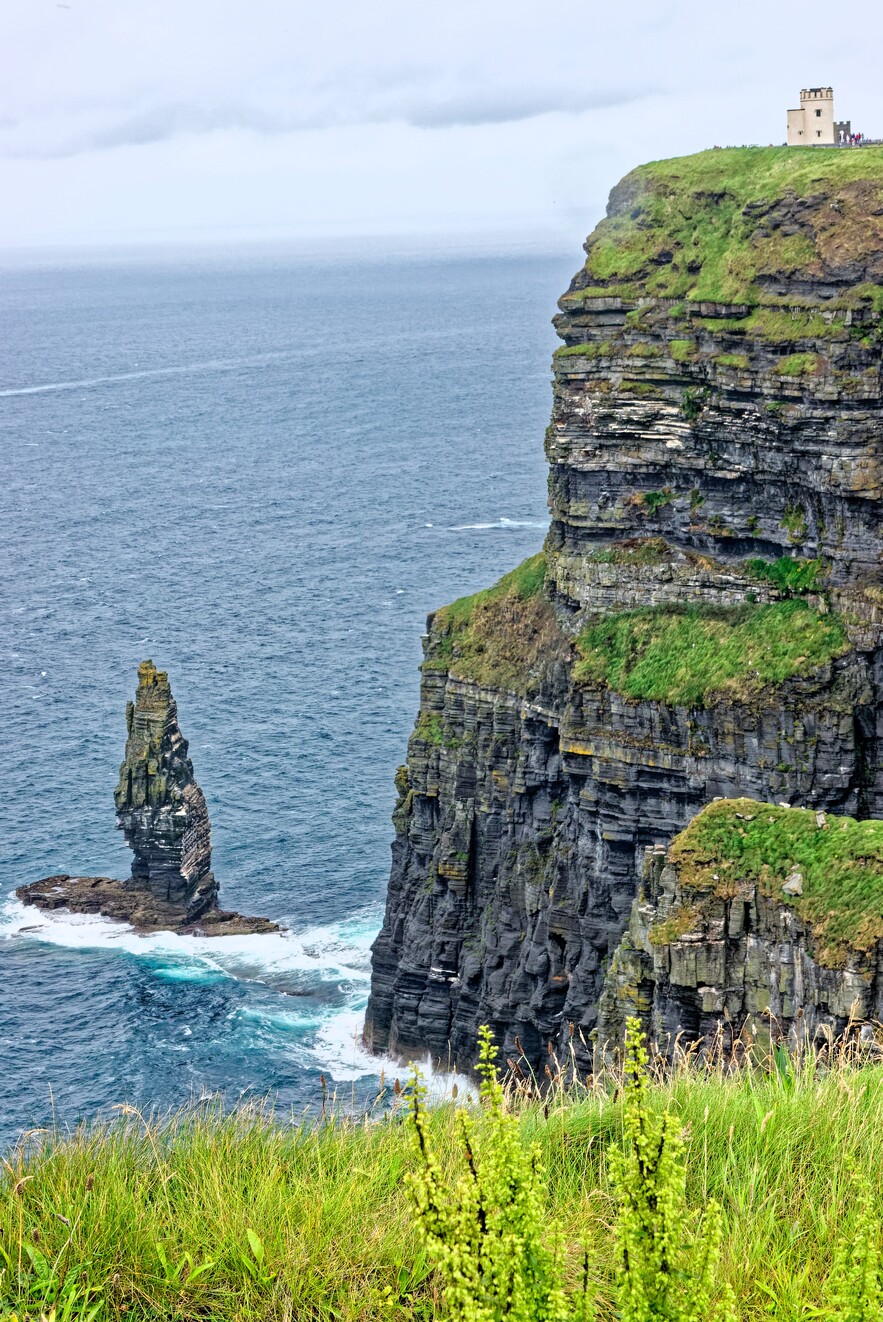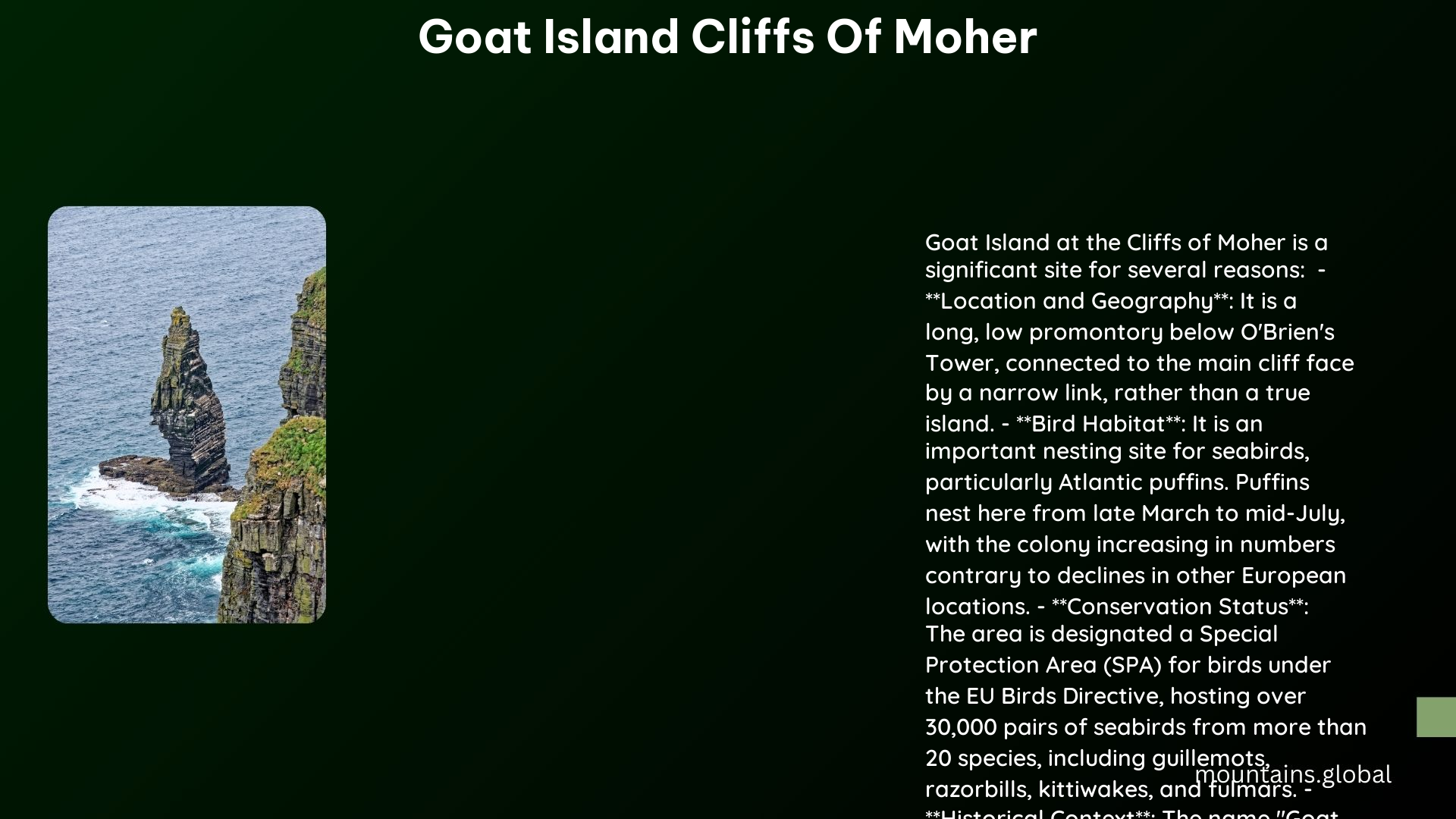Goat Island at the Cliffs of Moher is a captivating natural wonder along Ireland’s western coast. While not accessible to visitors, this rocky outcrop is home to a thriving puffin colony and offers breathtaking views from the nearby cliffs. Located within the iconic Cliffs of Moher, Goat Island provides a unique perspective on the raw beauty of Ireland’s Atlantic coastline, attracting nature enthusiasts, photographers, and birdwatchers from around the world.
What is Goat Island and Where is it Located?

Goat Island is not an island in the traditional sense, but rather a part of the cliff system at the famous Cliffs of Moher in County Clare, Ireland. It’s situated along the southwestern edge of the Burren region, facing the Atlantic Ocean. While visitors cannot set foot on Goat Island itself, it can be viewed from various vantage points along the Cliffs of Moher.
Key facts about Goat Island’s location:
- Part of the Cliffs of Moher in County Clare, Ireland
- Approximately 700 feet (213 meters) high
- Located about 5 miles (8 km) southwest of the village of Doolin
- Situated within the Burren and Cliffs of Moher UNESCO Global Geopark
The unique geological formation of Goat Island is a result of millions of years of erosion and natural processes, creating a stunning backdrop for wildlife and offering visitors a glimpse into Ireland’s ancient past.
How Can Visitors Access Views of Goat Island?

While Goat Island itself is inaccessible, visitors can enjoy spectacular views of this natural formation from various points along the Cliffs of Moher. Here’s how to access the best viewpoints:
-
South Platform: This is the prime location for viewing Goat Island and its famous puffin colony. The platform offers panoramic views of the cliffs and the Atlantic Ocean.
-
O’Brien’s Tower: Located at the highest point of the Cliffs of Moher, this 19th-century tower provides expansive views of the entire cliff system, including Goat Island.
-
Cliff Edge Walk: For the more adventurous, a guided walk along the cliff edge offers unique perspectives of Goat Island and the surrounding landscape.
To reach these viewpoints:
- Drive to the Cliffs of Moher Visitor Centre (approximately 3 hours from Dublin or 1.5 hours from Galway)
- Take a public bus service to the Cliffs of Moher
- Join an organized tour that includes transportation and guided walks
Remember to check the weather forecast before your visit, as clear days offer the best visibility for viewing Goat Island and its wildlife.
What Wildlife Can Be Observed at Goat Island?
Goat Island is renowned for its diverse wildlife, particularly its seabird populations. The island’s steep cliffs and rocky outcrops provide ideal nesting sites for various species. Here’s a breakdown of the wildlife you might observe:
| Species | Best Viewing Time | Interesting Facts |
|---|---|---|
| Atlantic Puffins | April to August | Nicknamed “sea parrots” due to their colorful beaks |
| Razorbills | March to August | Can dive up to 120 meters deep for fish |
| Guillemots | Year-round | Also known as “common murres” |
| Kittiwakes | March to September | Named for their distinctive call |
| Fulmars | Year-round | Can live up to 40 years |
| Peregrine Falcons | Year-round | The fastest animals in the world, reaching speeds of up to 240 mph during dives |
To enhance your wildlife viewing experience:
- Bring binoculars or a spotting scope for close-up views
- Visit during the breeding season (spring and summer) for the best chance to see puffins and other seabirds
- Join a guided wildlife tour for expert insights and the best viewing locations
What Makes Goat Island’s Geology Unique?
Goat Island’s geological formation is a testament to millions of years of natural processes. Understanding its geology can enhance your appreciation of this remarkable site:
- Rock Composition: Goat Island is primarily composed of:
- Namurian shale
- Sandstone
-
Siltstone
-
Age: The rocks date back to the Upper Carboniferous period, approximately 320 million years ago.
-
Formation Process:
- Layers of sediment were deposited in a large delta
- Over millions of years, these sediments were compressed and hardened into rock
- Tectonic movements lifted the rock layers
-
Erosion by wind and waves sculpted the cliffs into their current form
-
Unique Features:
- Horizontal bedding planes visible in the cliff face
- Sea stacks and sea arches formed by differential erosion
- Caves at the base of the cliffs, carved out by wave action
The geological significance of Goat Island and the surrounding Cliffs of Moher has led to their inclusion in the Burren and Cliffs of Moher UNESCO Global Geopark, recognizing the area’s outstanding geological heritage.
How Has Goat Island Influenced Local Culture and Folklore?
Goat Island, like many natural landmarks in Ireland, has woven itself into the fabric of local culture and folklore. While not as prominent in legends as some other Irish sites, it still holds a special place in the hearts and stories of the local people:
- Origin of the Name:
- Some locals believe the island was named after wild goats that once inhabited the area
-
Others suggest it’s due to the island’s resemblance to a goat’s head when viewed from certain angles
-
Legends and Myths:
- Tales of merfolk living in the caves beneath Goat Island
-
Stories of ancient Irish warriors using the cliffs as a lookout point
-
Cultural Significance:
- Featured in traditional Irish music and poetry
-
Inspiration for local artisans and craftspeople
-
Historical Importance:
- Used as a natural defense point during times of invasion
- Served as a landmark for fishermen and sailors
The cultural impact of Goat Island extends beyond local folklore, influencing modern art, literature, and film. Its dramatic beauty has made it a popular location for photographers and filmmakers, further cementing its place in contemporary Irish culture.
What Are the Best Times to Visit Goat Island?
Choosing the right time to visit Goat Island can greatly enhance your experience. Here are some factors to consider:
- Wildlife Viewing:
- April to August: Best for puffin watching
-
March to September: Peak season for various seabird species
-
Weather Conditions:
- May to September: Generally milder weather with longer daylight hours
-
October to April: Potential for dramatic stormy seas, but also colder temperatures
-
Crowd Levels:
- June to August: Peak tourist season, expect larger crowds
-
September to May: Quieter periods, ideal for a more peaceful experience
-
Photography Opportunities:
- Early morning: Soft light and potential for misty conditions
-
Late afternoon: Golden hour lighting for stunning sunset shots
-
Seasonal Events:
- Check for local festivals or events that might coincide with your visit
Best times to visit based on different interests:
| Interest | Recommended Time |
|---|---|
| Wildlife Photography | April to August, early morning or late afternoon |
| Landscape Photography | Year-round, but especially during stormy weather for dramatic shots |
| Birdwatching | March to September |
| Avoiding Crowds | October to April, weekdays |
| Mild Weather | May to September |
Remember to always check the weather forecast and tide times before your visit, as these can significantly impact your experience and safety at the Cliffs of Moher and Goat Island.
What Photography Tips Can Enhance Captures of Goat Island?
Capturing the beauty of Goat Island and its surroundings requires some preparation and technique. Here are some tips to help you take stunning photographs:
- Equipment Recommendations:
- Wide-angle lens for sweeping landscape shots
- Telephoto lens (at least 300mm) for close-ups of wildlife
- Sturdy tripod to combat wind and ensure sharp images
-
Neutral density filters for long exposure shots of the sea
-
Composition Techniques:
- Use the rule of thirds to create balanced images
- Include foreground elements to add depth to your shots
-
Experiment with different angles and perspectives
-
Lighting Considerations:
- Golden hour (just after sunrise or before sunset) offers warm, soft light
- Overcast days can provide even lighting for capturing details
-
Be prepared for rapidly changing light conditions
-
Subject Focus:
- Puffins and other seabirds (best during breeding season)
- Dramatic cliff faces and rock formations
- Crashing waves and sea spray
-
Panoramic views of the coastline
-
Technical Tips:
- Use a small aperture (f/11 – f/16) for wide depth of field in landscape shots
- Faster shutter speeds for capturing birds in flight
-
Consider HDR techniques for high-contrast scenes
-
Safety and Etiquette:
- Stay on designated paths for your safety
- Respect wildlife and maintain a safe distance
- Be mindful of other visitors when setting up your equipment
Remember, the key to great photography at Goat Island is patience and preparation. The ever-changing weather and light conditions mean that each visit can offer unique photographic opportunities.
How Does Conservation Efforts Protect Goat Island’s Ecosystem?
Goat Island and the surrounding Cliffs of Moher are part of a delicate ecosystem that requires ongoing conservation efforts. Various organizations and initiatives work to protect this unique environment:
- Burren and Cliffs of Moher UNESCO Global Geopark:
- Promotes sustainable tourism
- Conducts geological and ecological research
-
Educates visitors about the area’s natural heritage
-
Cliffs of Moher Visitor Experience:
- Implements sustainable practices in facility management
- Provides educational programs about local ecology
-
Monitors and manages visitor impact
-
BirdWatch Ireland:
- Conducts regular surveys of seabird populations
- Advocates for protection of nesting sites
-
Raises awareness about threats to seabirds
-
Local Conservation Groups:
- Organize beach clean-ups
- Monitor water quality
- Report on illegal activities or environmental concerns
Key conservation initiatives:
- Restricted access to sensitive nesting areas
- Sustainable tourism practices to minimize environmental impact
- Ongoing research on the effects of climate change on local ecosystems
- Habitat restoration projects
- Public education programs on the importance of conservation
Visitors can contribute to conservation efforts by:
- Staying on designated paths
- Not disturbing wildlife
- Properly disposing of waste
- Supporting local conservation organizations
- Participating in guided eco-tours
By understanding and supporting these conservation efforts, visitors can help ensure that Goat Island and its unique ecosystem remain protected for future generations to enjoy.
What Nearby Attractions Complement a Visit to Goat Island?
While Goat Island and the Cliffs of Moher are undoubtedly the main attractions, the surrounding area offers numerous complementary sites that can enrich your visit:
- The Burren National Park:
- Located about 30 minutes drive from the Cliffs of Moher
- Features unique limestone landscape and rare flora
-
Offers hiking trails and guided walks
-
Doolin Village:
- Just 8 km north of the Cliffs of Moher
- Known for traditional Irish music sessions
-
Starting point for boat tours along the cliffs
-
Aran Islands:
- Accessible by ferry from Doolin
- Rich in archaeological sites and traditional Irish culture
-
Offers stunning coastal views and unique geology
-
Lahinch Beach:
- Popular surfing spot about 12 km from the Cliffs of Moher
- Beautiful sandy beach for relaxation or water activities
-
Home to Lahinch Golf Club, a world-renowned links course
-
Ailwee Cave:
- Located in the heart of the Burren, about 30 minutes drive from the Cliffs
- Features underground waterfalls and bear pits
-
Includes a birds of prey centre
-
Loop Head Peninsula:
- About an hour’s drive south of the Cliffs of Moher
- Offers dramatic coastal scenery and a historic lighthouse
-
Great for whale and dolphin watching
-
Poulnabrone Dolmen:
- Ancient portal tomb in the Burren, dating back to 4200 BC
- One of Ireland’s most iconic archaeological sites
- About 40 minutes drive from the Cliffs of Moher
These attractions offer a diverse range of experiences, from natural wonders to cultural sites, allowing visitors to fully immerse themselves in the rich heritage of County Clare and the west coast of Ireland.
Reference:
1. Cliffs of Moher Official Website
2. Burren and Cliffs of Moher UNESCO Global Geopark
3. BirdWatch Ireland
4. Discover Ireland – The Burren
